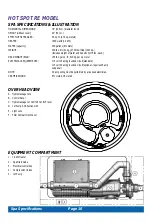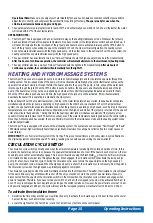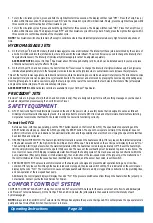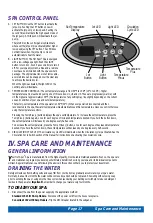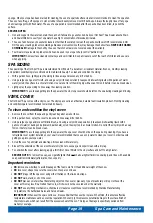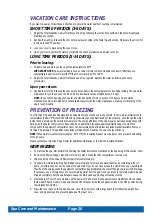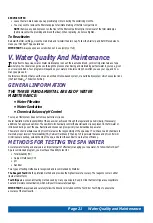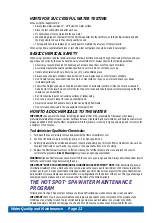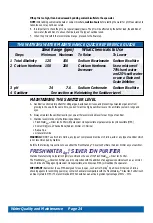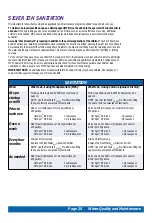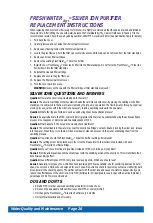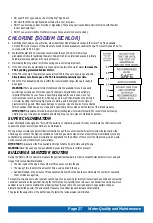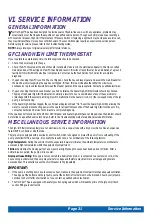
FILLING THE SPA WITH WATER
A. To prevent contaminants from entering the spa, Watkins recommends using the FreshStart
™
10,000
Pre-filter when filling
the spa with water. Always fill the spa through the filter compartment.
B. The FreshStart
™
10,000
Pre-filter is designed to remove unwanted contaminants such as rust, dirt, detergents and algae
from the fill water. Dissolved minerals and metals such as lead, calcium, copper and iron are not removed.
C. Instructions are included with the FreshStart
™
10,000
Pre-filter. When the spa is filled, proceed to the Start-Up and Refill
Procedures on page 14.
BALANCING THE TOTAL ALKALINITY (TA)
A. The recommended Total Alkalinity (TA) for your spa water is 125-150 ppm.
B. Total Alkalinity is a measure of the total levels of carbonates, bicarbonates, hydroxides, and other alkaline substances
in the water. TA is referred to as the water’s “pH buffer”. In other words, it’s a measure of the ability of the water to
resist changes in pH level.
C. If the TA is too low, the pH level will fluctuate widely from high to low. Fluctuations in pH can cause corrosion or
scaling of the spa components. Low TA can be corrected by adding sodium bicarbonate.
D. If the Total Alkalinity is too high, the pH level will tend to be high and may be difficult to bring down. It can be lowered
by using sodium bisulfate.
E. Once the TA is balanced, it normally remains stable, although the addition of more water with a high or low alkalinity
will raise or lower the TA reading of the water.
F. When the Total Alkalinity is within the recommended range, proceed to the next step.
BALANCING THE CALCIUM HARDNESS (CH)
A. The recommended Calcium Hardness (CH) level for your spa is 150-200 ppm.
B. Calcium Hardness is a measure of the total amount of dissolved calcium in the water. Calcium helps control the
corrosive nature of the spa’s water. That’s why calcium-low water (commonly known as “soft” water) is not
recommended. It is very corrosive to the equipment, and can cause staining of the spa shell. Calcium hardness
increaser is the antidote.
C. If the CH is too high (commonly known as “hard water”), formation of scale on the spa’s shell surface and equipment
can result. CH can be decreased by dilution–a mixture of 75% hard and 25% soft water will usually yield a
reading within the correct range. If soft water is not available or practical for you, a stain and scale control should be
added to the spa water, according to instructions on its label.
D. Once the CH is balanced, it normally remains stable, although the addition of more water with a high or low calcium
content will raise or lower the CH reading of the water.
E. When the Calcium Hardness is within the recommended range, proceed to the next step.
BALANCING THE PH
A. The recommended pH level for your spa water is 7.4-7.6.
B. The pH level is the measure of acidity and alkalinity. Values above 7 are alkaline; those
below 7 are acidic. Maintaining the proper pH level is extremely important for:
• Optimizing the effectiveness of the sanitizer.
• Maintaining water that is comfortable for the user.
• Preventing equipment deterioration.
C. If the spa water’s pH level is too low, the following may result:
• The sanitizer will dissipate rapidly.
• The water may become irritating to spa users.
• The spa’s equipment may corrode.
If the pH is too low, it can be increased by adding sodium carbonate to the spa
water.
D. If the pH level is too high, the following may result:
• The sanitizer is less effective.
• Scale will form on the spa shell surface and the equipment.
• The water may become cloudy.
• The filter cartridge pores may become obstructed.
Page 23
Water Quality and Maintenance
Содержание HOT SPOT RE
Страница 1: ...Owner s Manual ...


